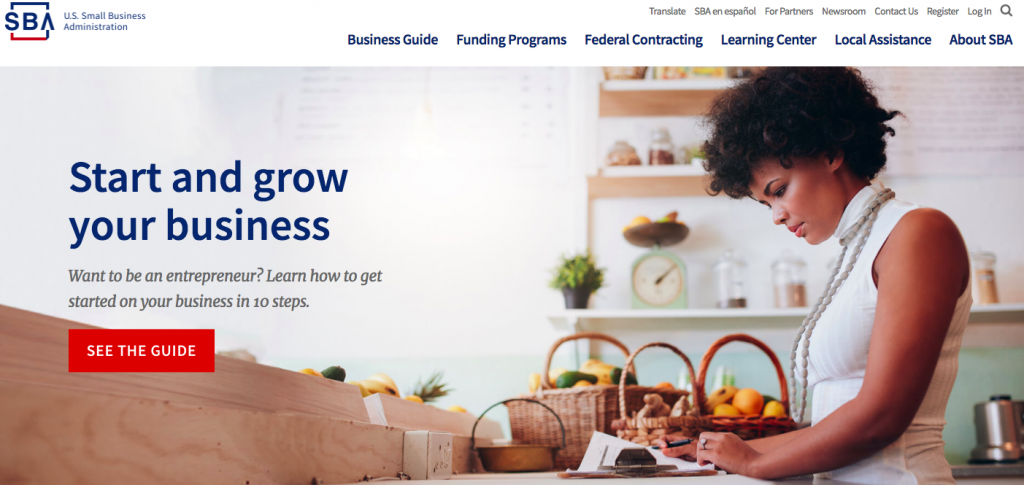For any small business owner who has looked online for relevant resources, there’s a good chance that SBA.gov ranked high in their search engine results.
“The problem is most of the [website] pages had a 60 to 80 percent bounce rate,” said Ryan Hillard, a Digital Service Specialist, who reports under SBA’s Office of Chief Information Officer-Business Technology Solutions (BiTS) division. “So we were really well optimized for search results, … but we were really bad at giving you actually what you were looking for once you got to us.”
Direct feedback from website users backed up the data. In response to a user survey, people expressed frustration with the website, saying it was confusing and difficult to find what they needed, said Emily Meeks, quality lead for the OCIO-BiTS-Digital Service team. Plus, the site was designed to fit SBA employees’ 17-inch computer monitors, rather than being optimized for actual small business users.
SBA’s Response
Improving the SBA’s web presence was about more than technology and design changes; it marked the need for a complete culture shift.
For starters, the OCIO-BiTS-Digital Service team encouraged employees to start seeing the website as their biggest field office, or their greatest opportunity to offer services to small-business owners, Hillard said. “That was the impetus for redoing SBA.gov and redoing it in a way where it offered functional tools and actually helped small-business owners get what they needed done or completed.”
Meeks shared that one of the most challenging parts of the project has been convincing people to embrace human-centered design, where they put citizens at the center of design processes — not themselves.
The fact is that SBA.gov is not for the agency, Hillard said. It’s for small businesses. Planning for the website redesign began around April 2016 and at first was little more than a grand idea on a Post-it. The effort has since evolved into a multi-faceted project that is expected to be completed in September 2018 — although no website is ever truly final. There will be future tweaks and updates.
To ensure success of the project, the team used Agile for project management and software development. This stipulation was also written into contracts, and it required vendors to deliver functionality every two weeks. The team also worked closely with subject- matter experts, contractors and users to ensure information was accurate and accessible in a way that met users’ needs. DevOps also played a big role in the team’s success.
“For us, DevOps really meant trying to get us to a point where our developers had as much control over their destiny and over the operational status of the system,” Hillard said.
The Outcome
The new SBA.gov is in plain language and it’s accessible, mobile-friendly and 508-compliant, Meeks said. There’s also a feedback mechanism for customers that’s built into the website.
To track how website visitors interact with the content, what they click on and where they drop off, the team uses event-driven analytics.
Before the redesign — which is still in progress — the SBA website had several articles related to small-business size standards. “The Small Business Administration has very few things that it’s actually the source of truth for in the world,” Hillard said. “This is one of them. So this is really important that we get this right because we determine if you’re a small business or not.”
But the old website made it tough for small businesses to easily confirm if in fact they were a small business. To simplify the process, the OCIO-BiTS-Digital Service team bundled the various sources of information into an online size standards tool. Businesses can now use the interactive tool to see if they meet SBA’s size standards without having to leave the website. Previously, users would have to visit another website to find their NAICS code — a standard used by federal statistical agencies in classifying business establishments.
Overall, the tool is more user-friendly. “As the site matures, that’s the kind of experience that you’re going to see is,” said John Foster with Fearless Solutions, who serves as engagement lead on the project. There’s a general flow to business, Foster noted. Information on SBA.gov should align with that flow and make it easy for businesses to navigate the site, find what they need and take action. That’s a critical part of the online experience.
Tips for Getting Started
“[Agencies] need to put together a versatile team that represents three primary skillsets,” Hillard said. Those skills include design resources, someone who is a product owner or has a product management background and experience, and someone who is technically savvy and can call out bad practices that could jeopardize the success of the project.
Foster added that acquisition doesn’t have to be a barrier when implementing digital services. If you need help getting started, check out the TechFAR, which highlights flexibilities in the Federal Acquisition Regulation (FAR) that can help agencies implement “plays” outlined in the Digital Services Playbook, he said.
